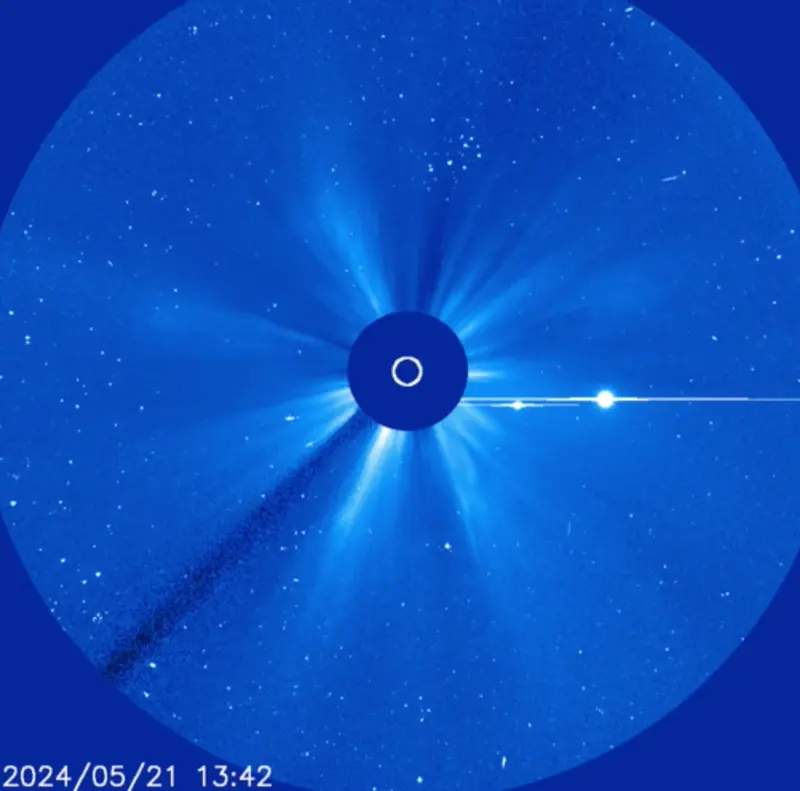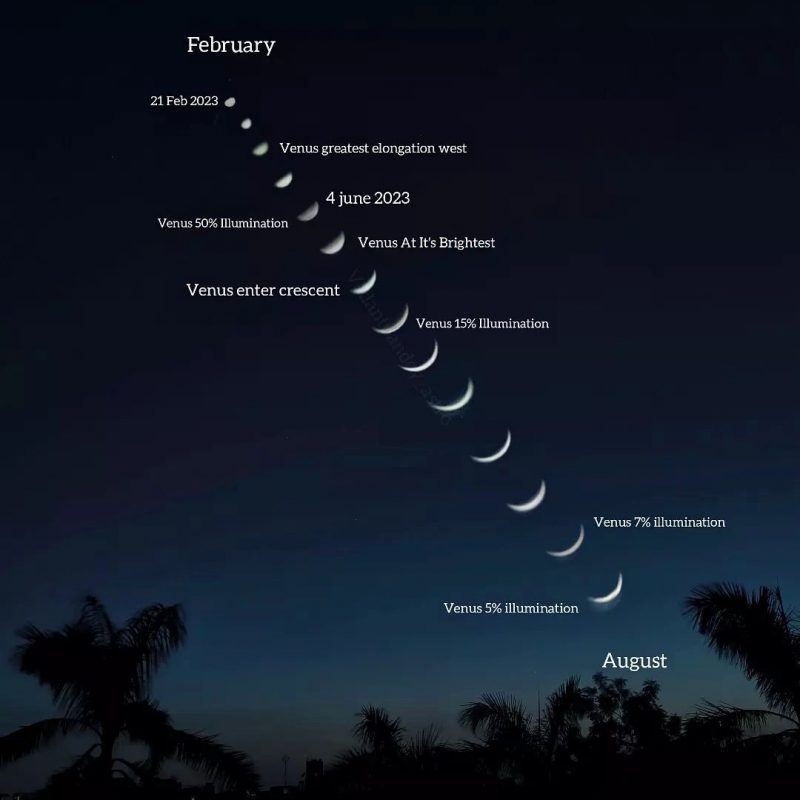
Venus superior conjunction June 4
Venus is the brightest planet we see. It orbits the sun one step closer than Earth. So it stays near the sun in our sky and is often called the morning “star” or the evening “star.” When it’s up, you can spot Venus easily. And it’ll catch your eye if it’s near a crescent moon. But where is Venus now? On June 3 and 4, it is passing directly behind the sun.
Prior to early June 2024, Venus spent over eight months as a dazzling morning “star.” It reached greatest elongation – its greatest apparent distance from the sun in our sky – on October 23, 2023. It hung low in the east before sunrise for many months, before slipping away in the morning sunlight in early April. For the past couple of months, it’s been too close to the sun to see. Venus is now traveling behind the sun as viewed from Earth. It’ll reach its superior conjunction – achieving the same east-west coordinate as the sun in our sky – at 16 UTC (11 a.m. central) on June 4, 2024.
And, at this 2024 superior conjunction, Venus is passing behind the sun as seen from Earth! See the image above.
Venus comes to a superior conjunction every 584 days. Usually, it passes above or below the sun in our sky. At every superior conjunction, Venus moves from our morning sky to our evening sky. We can’t see Venus now, at the beginning of June 2024. But it’ll emerge into our evening sky in mid- to late summer. At this time, it’ll appear as a bright light in the western evening twilight: the glittering evening “star.”
When will you see Venus in the evening? Possibly as early as mid-July, and certainly (assuming you have a clear eastern horizon) by late July or early August. It’ll be easier to spot from Earth’s Southern Hemisphere than for us in the north. For all of us, Venus will ascend gradually in the evening twilight throughout July and August, 2024. Overall, at this evening apparition, it’ll spend about eight months as a brilliant light in the evening sky. It’ll disappear again, passing back into the sun’s glare (in front of the sun this time) in March, 2025.

Venus behind the sun
During this superior conjunction of Venus, the planet won’t just pass near the sun in our sky. It’ll go briefly behind the sun as seen from Earth. That is, the sun will occult or pass in front of Venus. According to Guy Ottewell in his 2024 Astronomical Calendar:
It ascends through the ecliptic plane on June 6, (2024), so that at the superior conjunction – only a day and a half earlier – it is actually occulted by the sun.
When will you next see Venus?
Venus will emerge in the western evening twilight in mid- to late July. But, as seen from Earth’s Northern Hemisphere, it’ll be setting less than an hour after the sun by month’s end. Luckily, Venus is the brightest planet, so you might be able to spot it low on the horizon. In mid- to late July, look for it about 30 minutes after sunset. It’s so bright, it’ll show even in the bright evening twilight.
In August, Venus will become easier to spot. It’ll be best in 2024 from October through the end of the year. Unfortunately for us in the Northern Hemisphere, the autumn months will feature the ecliptic – or path of the sun, moon and planets – making a narrow angle with the western evening horizon. So, around October, November and December, Venus’ distance from the sun will be mostly sideways with respect to the sun along our western horizon, not up above the sun.
But that will change as 2025 opens. Venus will reach greatest elongation – its greatest apparent distant from the sun – on February 4, 2025. And by then the ecliptic will be beginning to appear more perpendicular with respect to the sunset. So Venus will be respectably high in the sky, even from the northern half of Earth’s globe.
Be sure to watch for Venus in the weeks around February 15, 2025, when it’ll be heading for another greatest brilliancy in our sky.
It’ll disappear from view in the evening not long after that, going between the Earth and sun.
Photos of Venus


Bottom line: Venus reaches superior conjunction – passing between the sun and Earth – at 16 UTC on June 4, 2024, (11 a.m. CDT).
The post Venus superior conjunction: Venus going behind the sun today first appeared on EarthSky.
from EarthSky https://ift.tt/Xhnwzjs

Venus superior conjunction June 4
Venus is the brightest planet we see. It orbits the sun one step closer than Earth. So it stays near the sun in our sky and is often called the morning “star” or the evening “star.” When it’s up, you can spot Venus easily. And it’ll catch your eye if it’s near a crescent moon. But where is Venus now? On June 3 and 4, it is passing directly behind the sun.
Prior to early June 2024, Venus spent over eight months as a dazzling morning “star.” It reached greatest elongation – its greatest apparent distance from the sun in our sky – on October 23, 2023. It hung low in the east before sunrise for many months, before slipping away in the morning sunlight in early April. For the past couple of months, it’s been too close to the sun to see. Venus is now traveling behind the sun as viewed from Earth. It’ll reach its superior conjunction – achieving the same east-west coordinate as the sun in our sky – at 16 UTC (11 a.m. central) on June 4, 2024.
And, at this 2024 superior conjunction, Venus is passing behind the sun as seen from Earth! See the image above.
Venus comes to a superior conjunction every 584 days. Usually, it passes above or below the sun in our sky. At every superior conjunction, Venus moves from our morning sky to our evening sky. We can’t see Venus now, at the beginning of June 2024. But it’ll emerge into our evening sky in mid- to late summer. At this time, it’ll appear as a bright light in the western evening twilight: the glittering evening “star.”
When will you see Venus in the evening? Possibly as early as mid-July, and certainly (assuming you have a clear eastern horizon) by late July or early August. It’ll be easier to spot from Earth’s Southern Hemisphere than for us in the north. For all of us, Venus will ascend gradually in the evening twilight throughout July and August, 2024. Overall, at this evening apparition, it’ll spend about eight months as a brilliant light in the evening sky. It’ll disappear again, passing back into the sun’s glare (in front of the sun this time) in March, 2025.

Venus behind the sun
During this superior conjunction of Venus, the planet won’t just pass near the sun in our sky. It’ll go briefly behind the sun as seen from Earth. That is, the sun will occult or pass in front of Venus. According to Guy Ottewell in his 2024 Astronomical Calendar:
It ascends through the ecliptic plane on June 6, (2024), so that at the superior conjunction – only a day and a half earlier – it is actually occulted by the sun.
When will you next see Venus?
Venus will emerge in the western evening twilight in mid- to late July. But, as seen from Earth’s Northern Hemisphere, it’ll be setting less than an hour after the sun by month’s end. Luckily, Venus is the brightest planet, so you might be able to spot it low on the horizon. In mid- to late July, look for it about 30 minutes after sunset. It’s so bright, it’ll show even in the bright evening twilight.
In August, Venus will become easier to spot. It’ll be best in 2024 from October through the end of the year. Unfortunately for us in the Northern Hemisphere, the autumn months will feature the ecliptic – or path of the sun, moon and planets – making a narrow angle with the western evening horizon. So, around October, November and December, Venus’ distance from the sun will be mostly sideways with respect to the sun along our western horizon, not up above the sun.
But that will change as 2025 opens. Venus will reach greatest elongation – its greatest apparent distant from the sun – on February 4, 2025. And by then the ecliptic will be beginning to appear more perpendicular with respect to the sunset. So Venus will be respectably high in the sky, even from the northern half of Earth’s globe.
Be sure to watch for Venus in the weeks around February 15, 2025, when it’ll be heading for another greatest brilliancy in our sky.
It’ll disappear from view in the evening not long after that, going between the Earth and sun.
Photos of Venus


Bottom line: Venus reaches superior conjunction – passing between the sun and Earth – at 16 UTC on June 4, 2024, (11 a.m. CDT).
The post Venus superior conjunction: Venus going behind the sun today first appeared on EarthSky.
from EarthSky https://ift.tt/Xhnwzjs

Aucun commentaire:
Enregistrer un commentaire